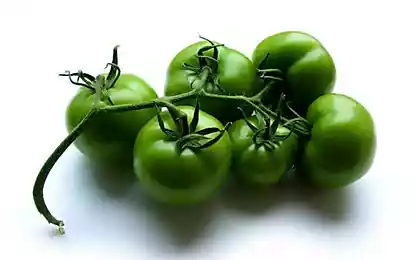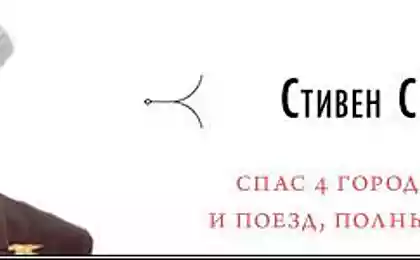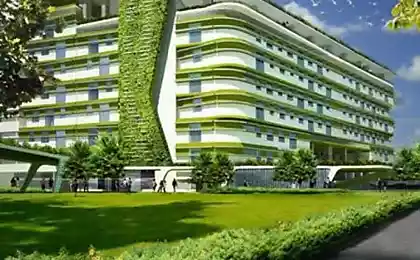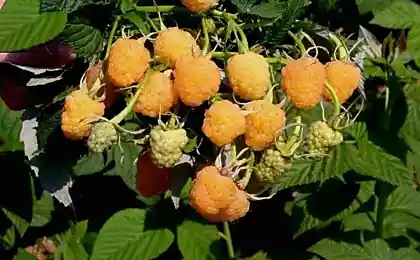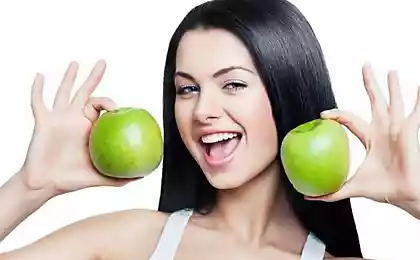635
Green murderer
"Uederbern lay on his back at the foot of the strange orchid. Similar tentacles aerial roots no longer hanging freely in the air, - having approached, they formed like a ball of gray rope, the ends of which are closely covered his chin, neck and hands. On his cheek under one of the predatory tentacles stretched thin trickle of blood »
(HG Wells, "The Strange Orchid»)

Sure, some HG Wells crossed the line, describing frankly cannibalistic tastes mysterious orchid. But what on earth safely, there are more than four hundred and fifty species of carnivorous plants - no doubt.
These green predators live primarily in areas with poor soil nutrients. And because nature "teach" them to produce their own "extra rations" uncharacteristic for flowers and blades of grass way - hunting and eating live prey.
Here are a couple of green swallow
In tropical Asia, on the island of Borneo, the Seychelles and Madagascar, New Guinea and northern Australia entwine trunks of large trees are long and thin, seemingly inconspicuous creeper called Nepenthes. In dozens of meters in height, they take out their narrow racemose inflorescence to reach the sunlight. Nepenthes Leaves, located closer to the stem, flat, wide and green, they perform the function of photosynthesis. But then the stalk is transformed into a thin mustache tightly wound around the host tree, and at the end of this strange mustache hanging "pitcher", a distance resembles a flower. This "pitcher" is designed to hunt for living beings.
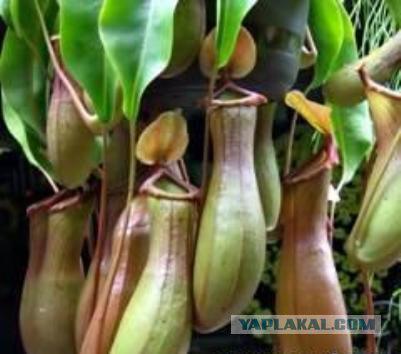
Different species of Nepenthes' kuvshi-us "-lovushki can be of different shapes, colors and sizes. Their length varies from two to thirty centimeters, but there are "pitchers" of up to half a meter. In such traps easily fit a bird or a rat. In order to trapping apparatus did not get rain water over its inlet raised "umbrella", which is the upper lobe of the leaf blade.
Most "pitchers" are painted in bright colors: red, matt white-colored spotty pattern or light green with purple spots. On the outside, a convex wall "jug" has a jagged rim. The upper edge curved inward, covered with pink or purple grooves, between which flows sweet scented nectar secreted by glandular nectaries. This nectar attracts insects from all sides and downright "pushes" them into "jug." But inside the heedless insects just waiting for death.
In the upper part of the inner wall "pitcher" arranged glands producing wax. The layer of wax - Dual: lower fine mesh consists of a thickness of 1-2 microns and the top - from nonoverlapping microscopic scales, which adhere to the legs of the victim and, coming off the lower layer, make it as skating, slide down.

If the prisoners knew what to expect next, it would do best to leave the horrible place. Because the bottom of this attractive and fragrant from the outside, "pitcher" is a real hell for insects. This is not a flower, but rather to the stomach of an animal, the bottom of which the digestive glands secrete a huge amount of stomach acid and formic acid, which acts as an antiseptic. In large "jugs" collects up to two liters of this sinister mix, capable of in a few hours to dissolve the chitin even the cover, which are floating, decomposing, hundreds of corpses "fell for" insects. The aroma in the bottom of the jug is also significantly different from the external odors and poor.

On the banks of freshwater, wet soils are Nepenthes, have underground rhizomes creeping along the ground and lateral shoots; "Pitchers" of such plants hidden in the grass, turning into real for trapping crawling insects. Singling out a large number of fragrant sweet nectar, "pitchers" of "sweet path" leading to the death of insects.
It is interesting that until now did not really figure out why flying insects can not leave the "pitchers" -lovushki. After all, in fact they were not holding anything. Scientists have suggested that there is a role played by the intoxicating smell that just a fraction of a second confuses the victim and it lulls.

In peat bogs can find another carnivorous plant, which has no obvious traps in the form of a "pitcher" or "jaw", but it is no less dangerous for insects. This so-called rotundifolia sundew.
The leaves are covered with fine hairs of her tentacles, topped with a red head. At the center of the leaf hairs are short, close to the edge - longer. This plant is abundantly clear sticky liquid releases and therefore has a look as if from all sides is covered with dew, and where did the name itself - sundew.

Ants, flies and beetles, attracted by the bright shining brilliantly droplets fly or crawl on the sheet and then stick to it. Once the victim starts to fuss, trying to escape from it intentionally or unintentionally hurt neighboring hairs that serve like flycatchers, a kind of alarm. They, in turn, stuck to more insect and leaf sundew, subject to signal that the production "caught", slowly roll up into the tube until it closes the prey whole.

There, under the sheet, away from prying eyes, and going unattractive process of digestion. Fluid released hairs, its composition is similar to the gastric juice of animals. Overcooked insects are the same pieces of iron are absorbed into the plant.
Based on these facts, it can be assumed that there are plants that are dangerous not only for insects but also for humans. But scientists are skeptical about this assumption.
Taken here

And recalled the Venus flytrap
On it you can find in the posts here and here
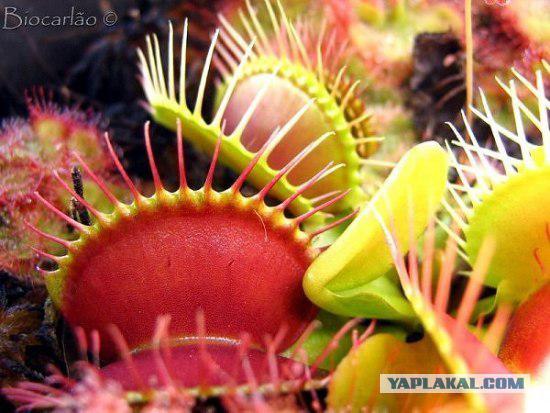
Source:
(HG Wells, "The Strange Orchid»)

Sure, some HG Wells crossed the line, describing frankly cannibalistic tastes mysterious orchid. But what on earth safely, there are more than four hundred and fifty species of carnivorous plants - no doubt.
These green predators live primarily in areas with poor soil nutrients. And because nature "teach" them to produce their own "extra rations" uncharacteristic for flowers and blades of grass way - hunting and eating live prey.
Here are a couple of green swallow
In tropical Asia, on the island of Borneo, the Seychelles and Madagascar, New Guinea and northern Australia entwine trunks of large trees are long and thin, seemingly inconspicuous creeper called Nepenthes. In dozens of meters in height, they take out their narrow racemose inflorescence to reach the sunlight. Nepenthes Leaves, located closer to the stem, flat, wide and green, they perform the function of photosynthesis. But then the stalk is transformed into a thin mustache tightly wound around the host tree, and at the end of this strange mustache hanging "pitcher", a distance resembles a flower. This "pitcher" is designed to hunt for living beings.

Different species of Nepenthes' kuvshi-us "-lovushki can be of different shapes, colors and sizes. Their length varies from two to thirty centimeters, but there are "pitchers" of up to half a meter. In such traps easily fit a bird or a rat. In order to trapping apparatus did not get rain water over its inlet raised "umbrella", which is the upper lobe of the leaf blade.
Most "pitchers" are painted in bright colors: red, matt white-colored spotty pattern or light green with purple spots. On the outside, a convex wall "jug" has a jagged rim. The upper edge curved inward, covered with pink or purple grooves, between which flows sweet scented nectar secreted by glandular nectaries. This nectar attracts insects from all sides and downright "pushes" them into "jug." But inside the heedless insects just waiting for death.
In the upper part of the inner wall "pitcher" arranged glands producing wax. The layer of wax - Dual: lower fine mesh consists of a thickness of 1-2 microns and the top - from nonoverlapping microscopic scales, which adhere to the legs of the victim and, coming off the lower layer, make it as skating, slide down.

If the prisoners knew what to expect next, it would do best to leave the horrible place. Because the bottom of this attractive and fragrant from the outside, "pitcher" is a real hell for insects. This is not a flower, but rather to the stomach of an animal, the bottom of which the digestive glands secrete a huge amount of stomach acid and formic acid, which acts as an antiseptic. In large "jugs" collects up to two liters of this sinister mix, capable of in a few hours to dissolve the chitin even the cover, which are floating, decomposing, hundreds of corpses "fell for" insects. The aroma in the bottom of the jug is also significantly different from the external odors and poor.

On the banks of freshwater, wet soils are Nepenthes, have underground rhizomes creeping along the ground and lateral shoots; "Pitchers" of such plants hidden in the grass, turning into real for trapping crawling insects. Singling out a large number of fragrant sweet nectar, "pitchers" of "sweet path" leading to the death of insects.
It is interesting that until now did not really figure out why flying insects can not leave the "pitchers" -lovushki. After all, in fact they were not holding anything. Scientists have suggested that there is a role played by the intoxicating smell that just a fraction of a second confuses the victim and it lulls.

In peat bogs can find another carnivorous plant, which has no obvious traps in the form of a "pitcher" or "jaw", but it is no less dangerous for insects. This so-called rotundifolia sundew.
The leaves are covered with fine hairs of her tentacles, topped with a red head. At the center of the leaf hairs are short, close to the edge - longer. This plant is abundantly clear sticky liquid releases and therefore has a look as if from all sides is covered with dew, and where did the name itself - sundew.

Ants, flies and beetles, attracted by the bright shining brilliantly droplets fly or crawl on the sheet and then stick to it. Once the victim starts to fuss, trying to escape from it intentionally or unintentionally hurt neighboring hairs that serve like flycatchers, a kind of alarm. They, in turn, stuck to more insect and leaf sundew, subject to signal that the production "caught", slowly roll up into the tube until it closes the prey whole.

There, under the sheet, away from prying eyes, and going unattractive process of digestion. Fluid released hairs, its composition is similar to the gastric juice of animals. Overcooked insects are the same pieces of iron are absorbed into the plant.
Based on these facts, it can be assumed that there are plants that are dangerous not only for insects but also for humans. But scientists are skeptical about this assumption.
Taken here

And recalled the Venus flytrap
On it you can find in the posts here and here

Source:
